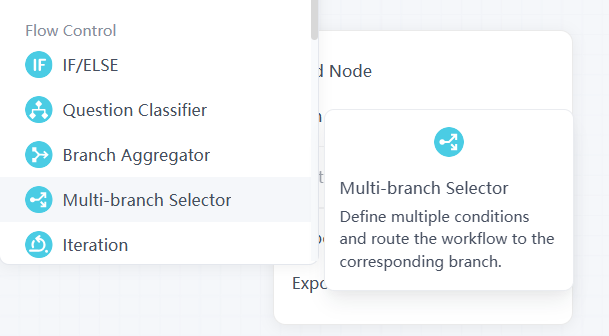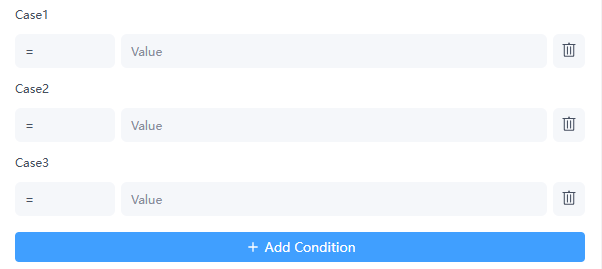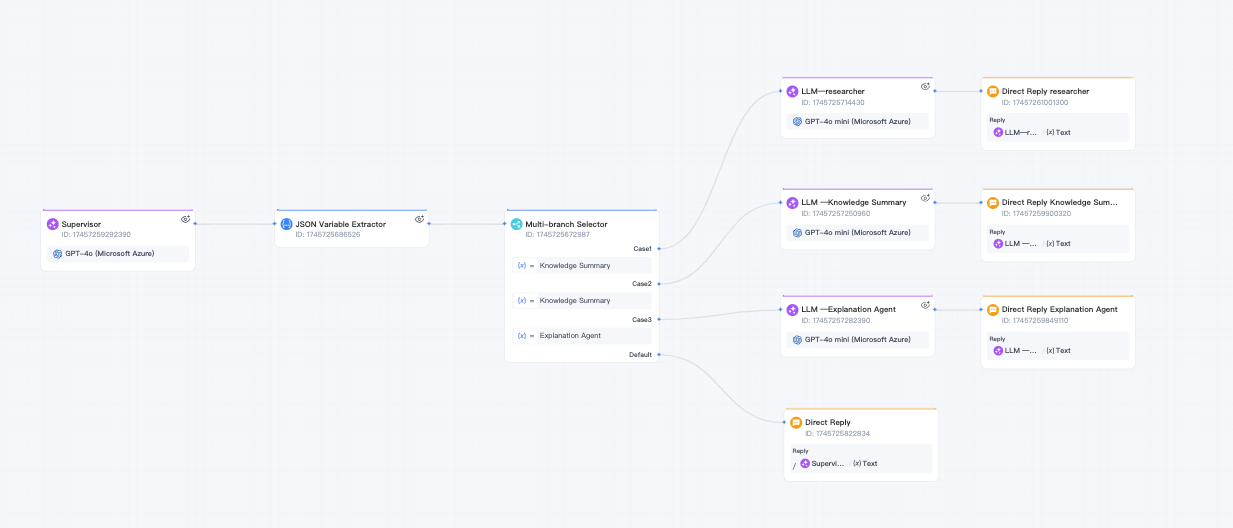Definition
In multi-category scenarios, implement diversion processing for different situations. Based on the conditions set for each branch, select the corresponding branch that meets the criteria to execute subsequent logical operations. During execution, the system will sequentially evaluate whether the conditions of each branch are satisfied.
If satisfied, the subsequent logic of that branch will be executed; if not, it will continue to evaluate the next branch's conditions. Each branch supports adding multiple conditions, with only "and" (logical conjunction) or "or" (logical disjunction) operations allowed between multiple conditions.

Quick Start / How to Use
Node configuration detailed instructions: In GoInsight.AI, right-click to select "Add Node" to add a Multi-branch Selector node to the workflow.

1.Configure the (x) variable for the Multi branch Selector node
In the "(x) Set Variable" input box, enter the variable used for evaluation. This variable can be from other nodes in the workflow, such as a numeric value, string, or boolean.

2.Configure the Case parameter for the Multi branch Selector node
First, select the operator, the operator shown in the image is = (equal to). Depending on your needs, you can choose other operators such as ≠ (not equal to), > (greater than), (less than), etc.

- Then, in the "Input Value" box, enter the value to compare with the variable. For example, if the variable is a numeric value, enter a specific number here; if the variable is a string, enter the corresponding string.
- Click the "+ Add Condition" button to add more branch conditions (Case2, Case3, etc.) as needed. For each newly added condition, select the operator and input the comparison value in the same way.
- If you need to delete a condition, click the "Delete" button on the right.
3.Configure the Default parameter for the multi-branch node
The "Default" section is used to define the logic to be executed when none of the "Case" conditions are satisfied. Here, you can configure default operations, such as returning a default value or executing a specific processing flow.

4.Configure the Remark parameter for the multi-branch node
In the "Remark" area, you can enter some explanatory information about this multi-branch node. For example, explain the business significance of these branch conditions, the purpose of the setup etc., to facilitate understanding and maintenance for yourself and others.

Application Skills
- Business Process Decision-Making: Guide the process direction based on different conditions within various business workflows.
- Data Processing and Filtering: Filter and classify data according to data characteristics in data processing tasks.
- Exception Handling and Error Management: Perform targeted handling when exceptions occur during program execution or business operations.
- Personalized Services and Recommendations: Provide personalized services based on user characteristics or behavior.
- Resource Allocation and Scheduling: In resource management scenarios, allocate resources reasonably based on resource usage and task requirements.
Typical Use Cases
1. Intelligent Transportation Systems
In intelligent transportation systems, multi-branch selection nodes can perform real-time traffic scheduling and management based on different traffic data. For example, branch decisions can be made based on information such as traffic flow, accident status, and weather conditions.
- If the traffic flow on a certain road segment exceeds the preset threshold and no accidents have occurred, the traffic signal can be controlled to extend the green light duration for that segment, guiding vehicles to pass quickly.
- If an accident occurs on a certain road segment and the traffic flow is heavy, traffic congestion warning information can be promptly released, guiding surrounding vehicles to detour.
- In the event of severe weather (such as heavy rain or snow), the road speed limit can be reduced, and electronic display screens can remind drivers to pay attention to safety.
2. Industrial Automation Systems
In industrial automation production lines, multi-branch selection nodes can perform different processing based on product quality inspection results, equipment operating status, and other information. For example:
- When the product quality inspection result shows that it is qualified and the equipment is operating normally, the product enters the normal packaging and warehousing process.
- If the product quality inspection result is unqualified but can be repaired to meet the standards, the product will be sent to the repair station for processing.
- If the equipment operating status is abnormal, such as excessive temperature or pressure, the production line will immediately be stopped, and an alarm will be sent to notify maintenance personnel for inspection.
Practical Scenario Cases

Notes
- Avoid excessive branching: If there are too many branches, it is recommended to split them into subprocesses.
- Avoid overlapping conditions: Multiple branch conditions may match simultaneously, leading to unpredictable results. Therefore, when comparing the set variable values with each branch condition in a multi-branch node:
- If the variable value satisfies a certain "Case" condition, execute the operation corresponding to that branch.
- If the variable value does not satisfy any "Case" condition, execute the operation defined by the "Default" branch.
- A simple drag-and-drop operation visualized low-code workflow editor enables AI to no longer merely "question and answer", but to integrate multiple nodes such as LLM, Python scripts, HTTP calls, and knowledge base retrieval into business scenarios, allowing both technical and non-technical users to easily turn their ideas into actual processes.
Frequently Asked Questions
- Multi-Branch Selector NodeEvaluates all branch conditions in parallel, with no priority order. Can match single or multiple branches simultaneously (requires configuration). Function Principle: Multi-way classification (e.g., order sorting).
- IF/ELSE NodeEvaluates in order of conditions; jumps on the first match. Only one path is selected.
Leave a Reply.